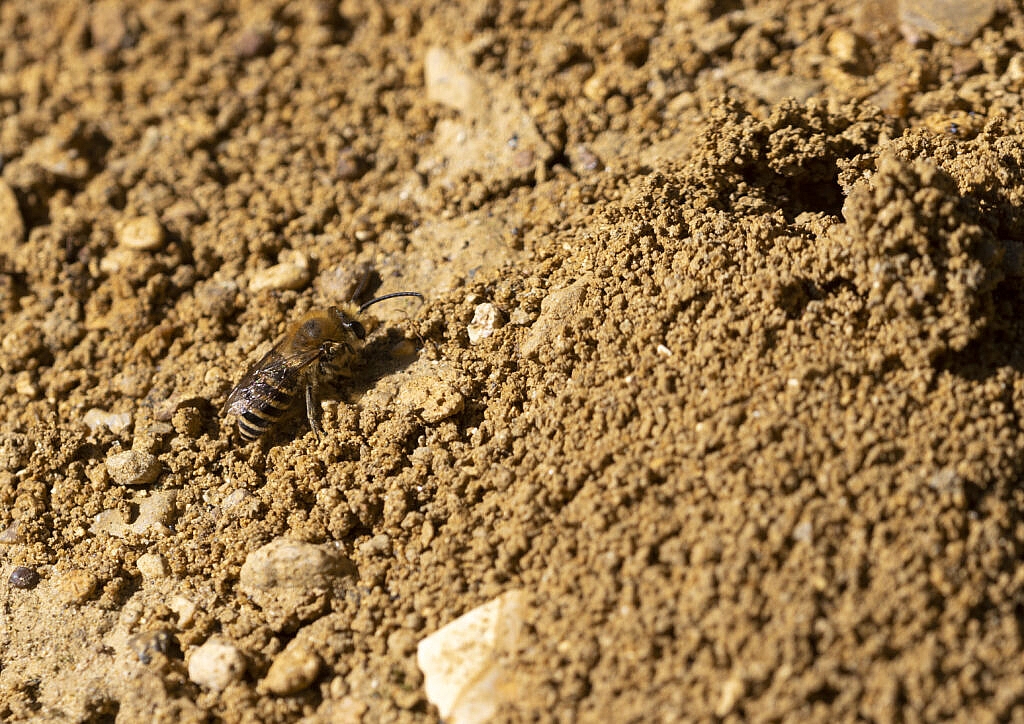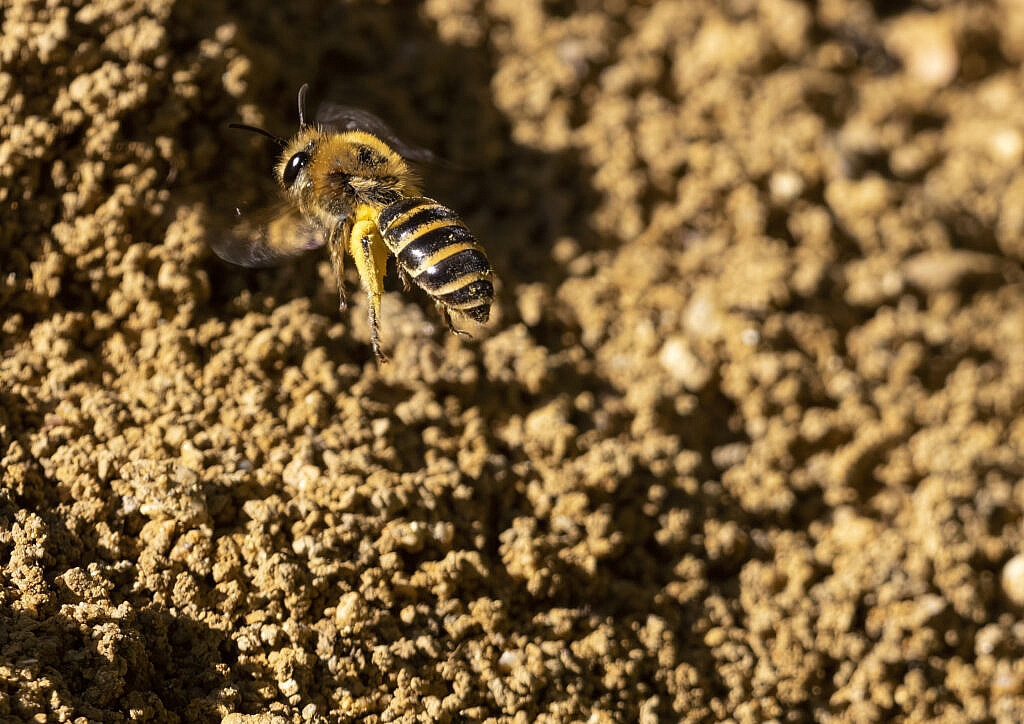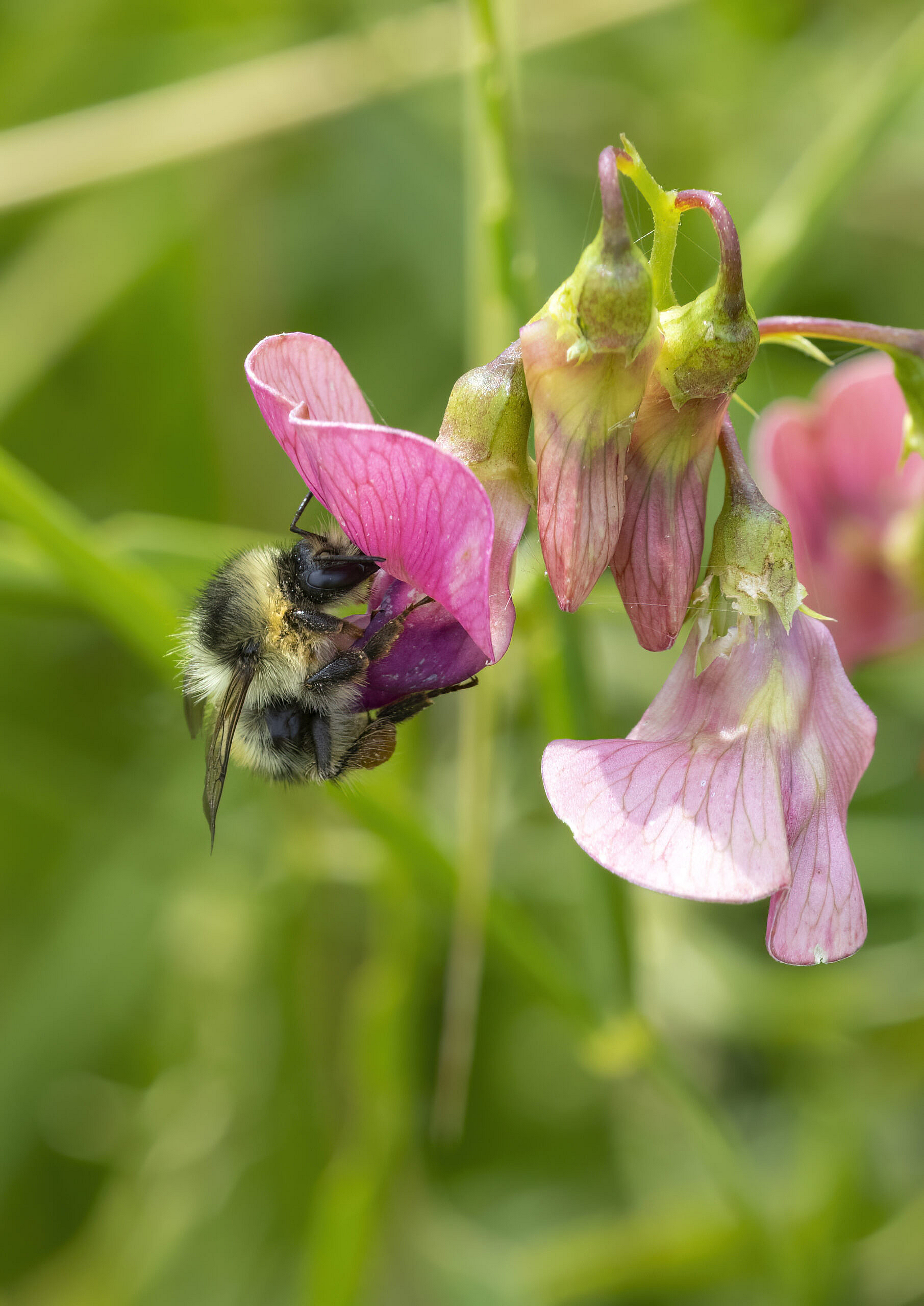In the autumn of 2001, a small discovery was made in Dorset. It was a very small discovery in fact – only around a centimetre long. It was the first sighting of a new bee species, the Ivy mining bee, in Britain. In fact, the Ivy mining bee is so easily overlooked that it was only discovered as a species just over 30 years ago in 1993. So when a friend of mine offered to show me some in Wiltshire, I jumped at the chance.
This small bee is a kind of bee called a called a ‘solitary’ bee. Astonishingly, for a kind of bee that most people have never heard of, there are 250 species of solitary bees, and they account for an astonishing 93% or so of all of Britain’s bee species. I covered another solitary bee, the two-coloured mason bee, in this blog post back in May: https://stevedeeley.com/?p=1115 .
When we think of bees, we tend to think of honeybees, which live in large families – there can be up to 80,000 honeybees in a bee hive. Bumblebees tend to live in small colonies, too, of perhaps 400 bees, where every bee is one of the queen bee’s children. But for solitary bees, one is the magic number, and they live – and die – alone. But they are nonetheless a communal bee, and while each will build it own nest and gather its own food, they will often share a good site with hundreds or even thousands of other mining bees.

Some of our most common solitary bees have ‘trade’ names – there are mining bees, wool carder bees, carpenter bees and mason bees. Perhaps because when you watch them, these tiny bees are always unbelievably busy, always rushing around, never sittings still. They have to be, because they don’t have a hive full of siblings to help out with the chores. And the Ivy Mining bee has to work harder than most, because it has very little time in which to get those chores done. It’s already late in the summer when, as August slips into September, a new female Ivy mining bee emerges from the underground burrow where she has lived through the winter, feeding on pollen left in the cell (small chamber) in which her egg was laid. She will never meet her parents, who died when the first really cold weather swept in the previous year. Now she emerges, and faces her first challenge. Male ivy mining bees hatch before the females do – male eggs are often laid in cells nearer to the nest entrance than the females to make sure of this. The males have only one thing on their mind. Slightly smaller than the females and with no stinger, they ceaselessly patrol any site where there is the scent of a female. The minute the female emerges, every male in the vicinity will pounce on her and try to mate with her. I missed the spectacle this year, but my friend hade watched the “bee balls”, bundles of male mining bees with an unfortunate female at the centre, rolling down the nest slope.
I watched the busy colony of ivy bees on a sandy slope in a woodland often used by BMX bikers. From a distance you couldn’t see any activity, but as you got closer you could see dozens (I counted perhaps 60) of these tiny bees seeming to bounce around a few centimetres above the ground. The slope was made of compacted sand, and covered with small 2cm-high sand piles where the bees had excavated their nests. Most of the bees I could see were males, ceaselessly patrolling in the hope of finding a late-emerging unmated female. But they were out of luck. Every female I saw was busy equipping their brood cells, flying along wearing bright yellow harem pants that turned out to be legs festooned in pollen. The males don’t bother a mated female, so the females would disappear into their tunnels, leaving the desperate males outside. I never saw a female re-emerge.

Once mated, the ivy mining bee has to live up to her name. She starts by digging a small hole into a patch of loose, crumbling soil or sand, preferably on a south-facing slope so that it doesn’t get waterlogged or frozen in the winter. This hole is perhaps 5mm wide but can extend anything up to a (truly astonishing) 60cm deep into the ground. That’s about the equivalent of me digging a tunnel the length of a football pitch – and with my bare hands. At the end of this long tunnel the bee digs a small number of cells, perhaps as many as six or eight, into each of which she lays eggs. She then emerges from the nest, leaving it unguarded, while she goes in search of pollen. Here is where the second part of her name comes in. It’s mid-late September by now, and the summer flush of meadow flowers is pretty much over. The bramble flowers have become blackberries, and most other plants are also busy building fruits and seeds, not flowers. But there is one flower that blooms late in the year: the ivy. And while the ivy mining bee will take pollen from other flower species, it’s the ivy that it strongly prefers. The female ivy mining bee makes trip after trip, collecting pollen for each of her cells – it can take a whole day of foraging to provision each cell – and in doing so is being an extremely good but almost disregarded pollinator. When she has supplied each egg cell with pollen, she will seal the nest. She has just six short weeks in which to emerge, mate, dig, lay her eggs and find the food for her brood before she dies – and you have to consider that at her size, a hard frost, heavy rain or even a very windy day will make that impossible, or even kill her before she’s finished.

Job done, both the male and female ivy mining bees will gradually die. Their eggs will lie safe and snug underground until the egg hatches, and the larva lives off the pollen stored in their cell until the following August when they, too, emerge as to continue their short life as ivy mining bees. This rather extreme lifecycle is a gamble for them. They gamble that their eggs will survive the winter, with their egg cells not getting flooded or frozen. And they gamble that when their offspring emerge, the ivy will be in flower and the bees able to fly. The gamble makes the ivy mining bee probably the last flying bee of the year, still in the air after all the honeybees and bumblebees are gone, giving them the advantage of having the ivy flowers – and any other flowers that are still hanging on – all to themselves. It seems to be paying off, as aided by our old friend global warming which is making our autumns milder and longer, the ivy mining bee establish is rapidly expanding its foothold in this country. It has spread across much of southern England, and scouts along the coastlines (which the bee likes because they are home to crumbling cliff edges) have made it as far North as Edinburgh.
So if you are out and about over the next few weeks, keep an eye open for the ivy mining bee. They can in theory sting, but hardly ever do so. So settle down to admire their industry, and say ‘hello’ to one of Britain’s newest insects.
You can find out more about the ivy mining bee in this episode of the BBC’s Living World: https://www.bbc.co.uk/programmes/b03g8d60




Social Profiles